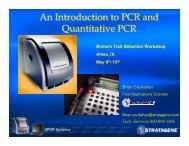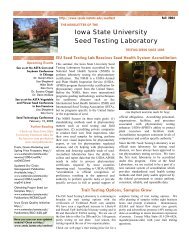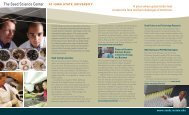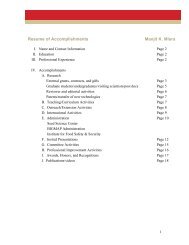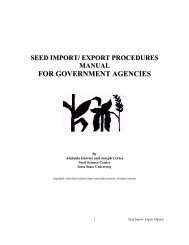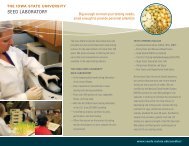Confined Production Processes for Non-Food Corn - Seed Science ...
Confined Production Processes for Non-Food Corn - Seed Science ...
Confined Production Processes for Non-Food Corn - Seed Science ...
Create successful ePaper yourself
Turn your PDF publications into a flip-book with our unique Google optimized e-Paper software.
• Specialized equipment is used <strong>for</strong> planting and harvest.The equipment is designed so that it can be cleanedcompletely be<strong>for</strong>e and after use.• Female plants on which seed is produced are detasseledor male sterile so that their pollen does not contributeto the final product (self-pollinated female seed is animpurity in the hybrid).• Buffers are used to restrict the flow of outside polleninto the field.• The teams are trained to be able to identify plants thatdo not fit the description of the corn that is supposedto be in the field. <strong>Corn</strong> has a long list of characters thatcan be observed by the trained eye. Laboratory tests canbe used to verify plant genotype if needed.• Off-type plants are removed.• Teams are routinely in the field at pollination time.Teams both control pollen flow by detasseling andmonitor isolation. The field would normally be inspecteddaily at flowering time. The teams ensure that noincorrect plants flower.• <strong>Seed</strong> is usually harvested on the ear. <strong>Seed</strong> is usuallyharvested at 25–35% moisture to avoid loss in the fielddue to insects and kernels separating from the ear.• Most seed is harvested with pickers. Combines are notused. The most modern pickers leave the husk on theear so that the ear is protected from damage on its wayto the plant• Husk-on pickers dislodge very few kernels from theears in the field.• Husk-on pickers are easy to clean. It is possible toremove all ears and effectively all loose kernels.Characteristics of hybrid seed production at the plant:• Trained teams manage all activities in the process. Stepsare recorded.• At the plant the seed will be husked, sorted again <strong>for</strong>off-type ears, dried, shelled, and stored. Since theseprocedures are per<strong>for</strong>med at a central location, it ispossible to per<strong>for</strong>m them in buildings where all wastecan be managed and tracked.• Facilities can be cleaned completely between lines.• When conveyors are used they are specially selected<strong>for</strong> ease of cleaning.• All equipment is custom designed <strong>for</strong> easy of cleaning.• Modern genetic technology allows each line to be testedto ensure that each is correctly labeled.• Integrated computer systems track weight and purity.• Purity is checked be<strong>for</strong>e any line is released <strong>for</strong> use.Foundation seed production differs from regular hybridseed corn production in the following respects:In planning• <strong>Production</strong> is planned <strong>for</strong> multiple years both tocompensate <strong>for</strong> some of the risks inherent in production.By increasing the size of production fields, the rate ofimpurities can be reduced.In the foundation seed production field• Record keeping standards are higher then <strong>for</strong> commercialseed production.• The foundation production field is sometimes contractedfrom the farmer <strong>for</strong> the season so that the team hasmore control of the crops produced.• Quality is of higher importance and cost considerationsare of relatively lower importance than in hybrid seedproduction.• Genetic purity standards are higher. Isolation fromspecial kinds of corn (white corn and popcorn) is higherthan isolation required <strong>for</strong> other seed production.• Procedures are sometimes altered <strong>for</strong> the productionof quality foundation seed of hybrids with traits createdthrough biotechnology to ensure trait purity.• Isolation considerations tend to be more important inchoice of location than the characteristics of the ownerbecause more actions are handled by the foundationseed production team.• Many production locations are located within easydriving distance of a management center so that teamscan visit a number of fields easily and frequently.• Buffers of other crops are used between the outsideof the foundation field and neighboring corn. Infoundation seed production. these buffers are sometimesplanted by the company’s production team rather thanthe farmer operator.• Sterile females are sometimes used in production offemale lines. Good foundation production practice canmaintain the purity of sterile female lines to a level ofa few fertile plants in 10,000.• Small plots can be harvested by hand.• Larger plots are harvested with pickers.• Small amounts of seed can be transported in customboxes that are designed to be cleaned completely.• Larger amounts of seed can be transported indedicated wagons.• Commercial trucking is used in the largestfoundation fields.Larger Scale <strong>Production</strong> 53



